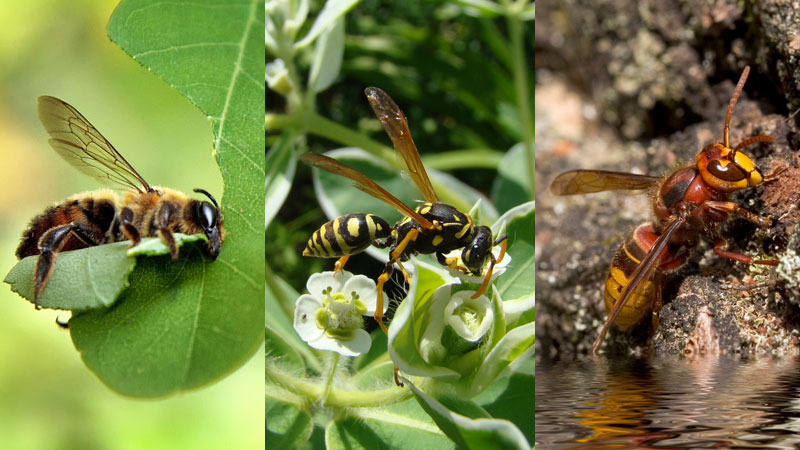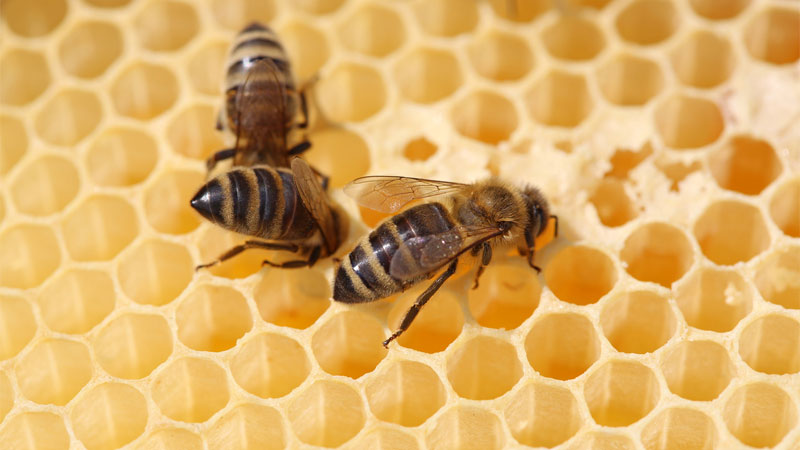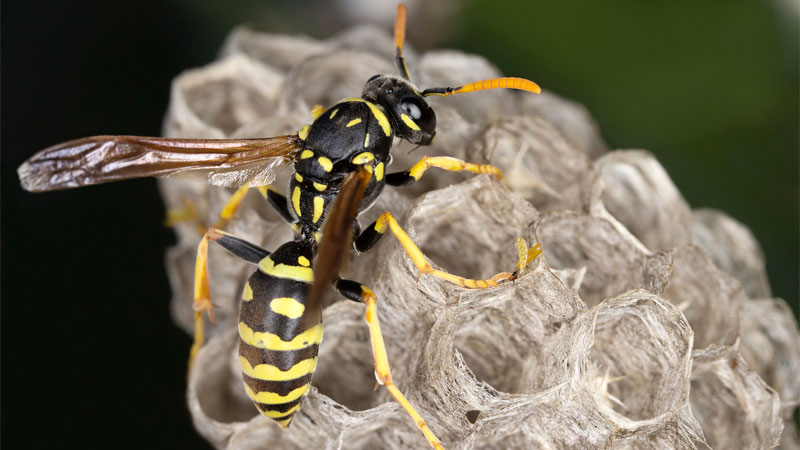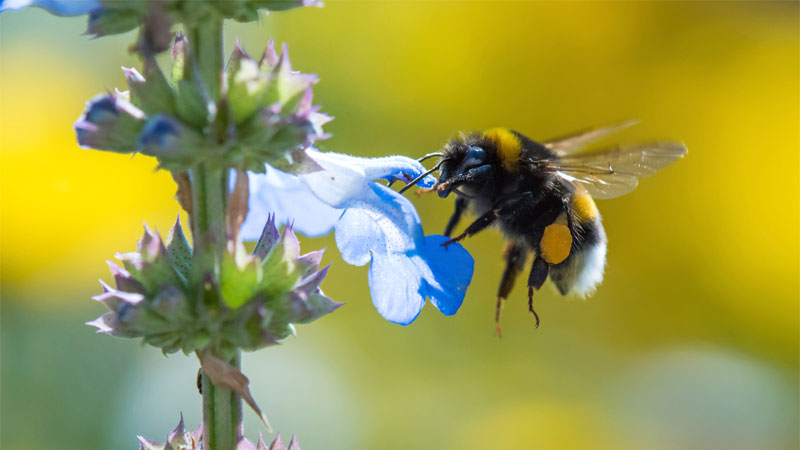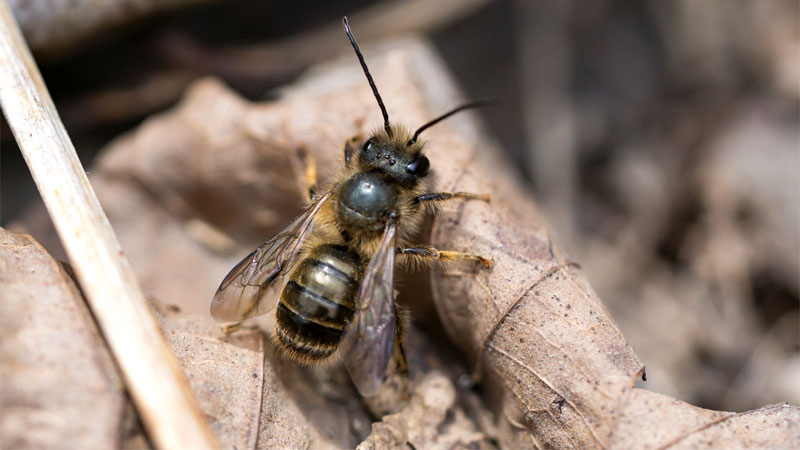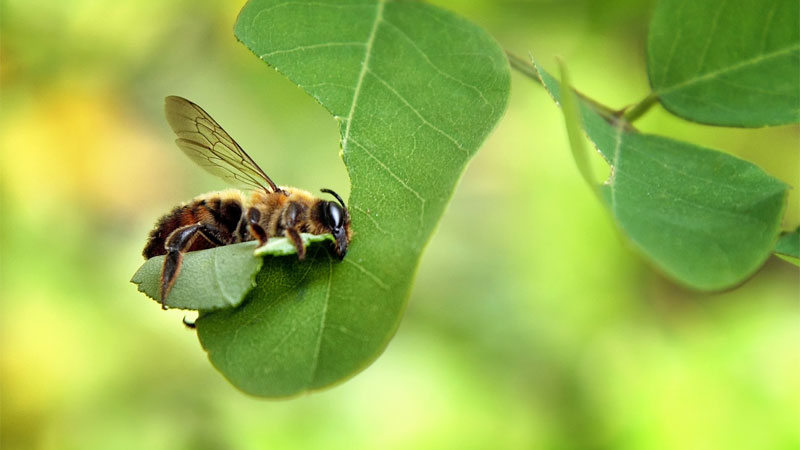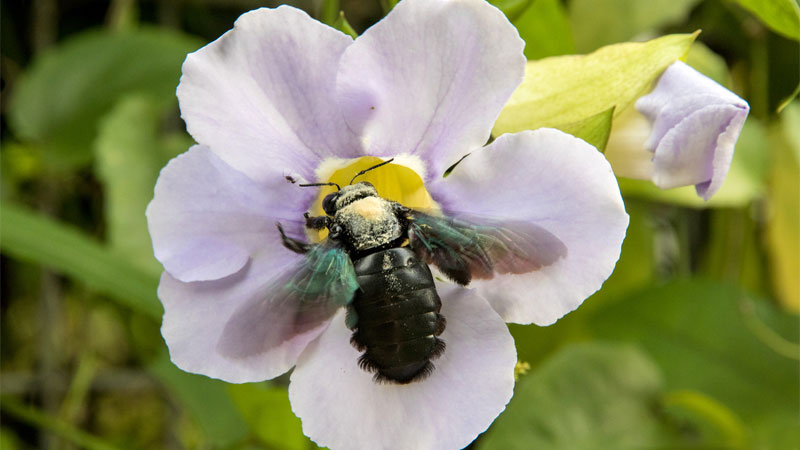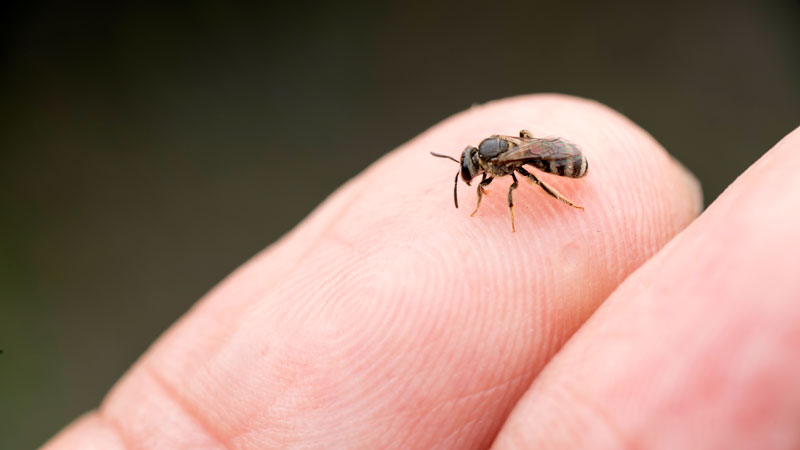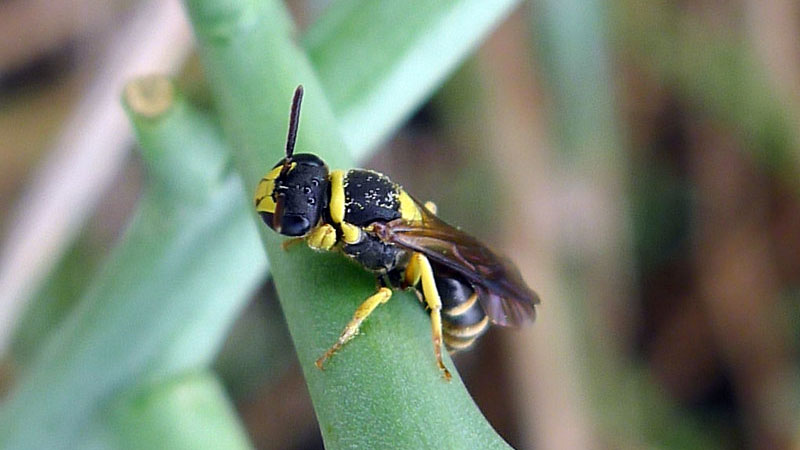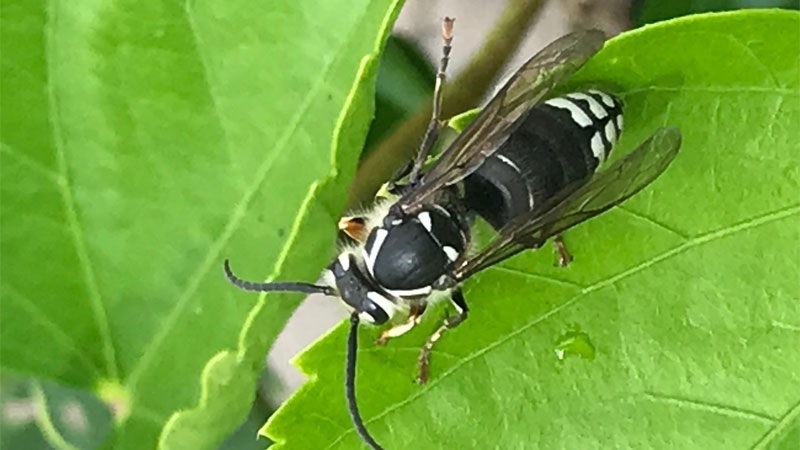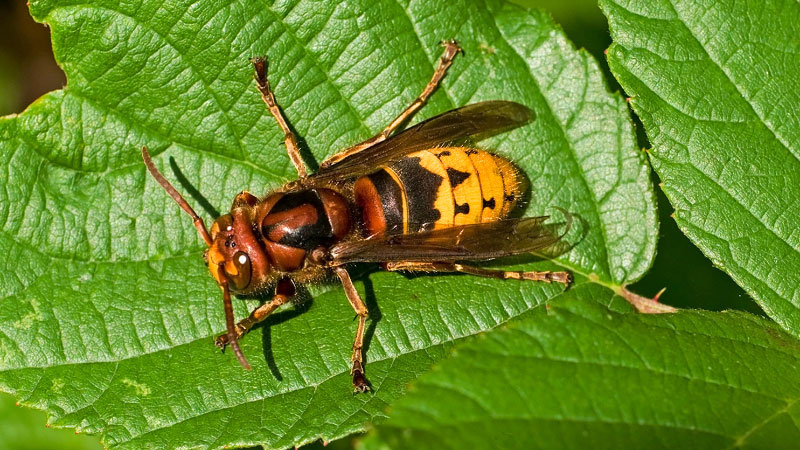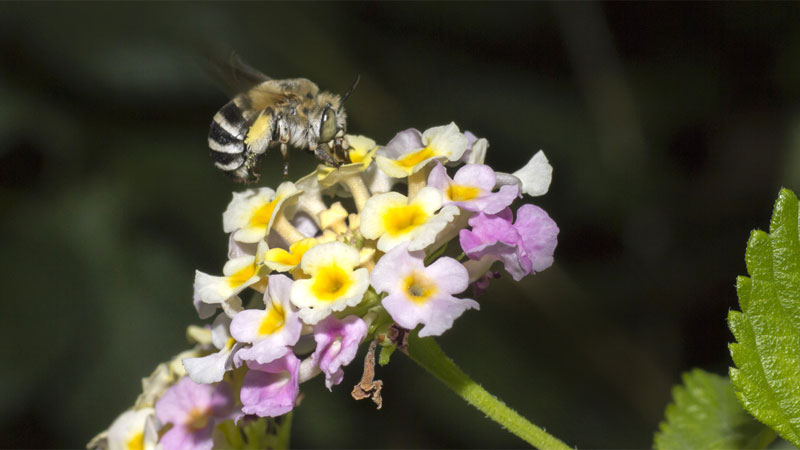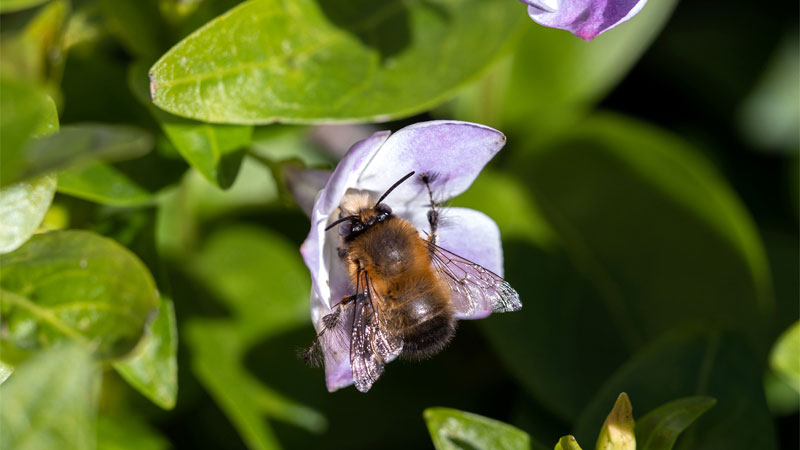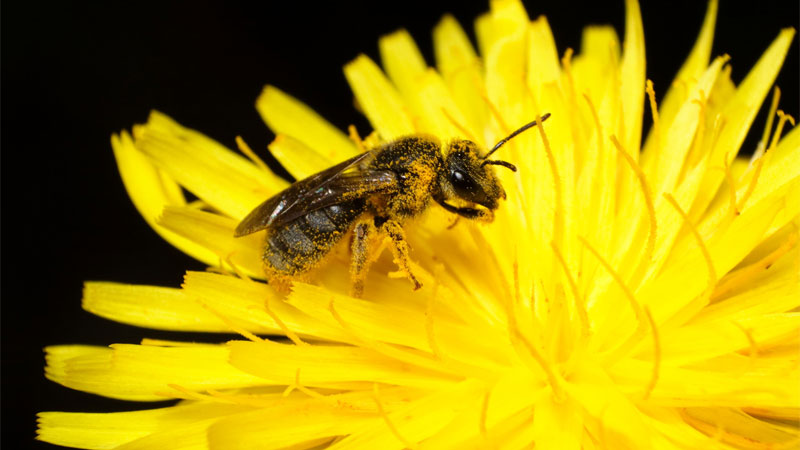One of (if not THE) most important critters to have in your yard or garden is the bee.
But how can you tell a bee from a wasp or hornet? Let’s go over some of the most common flying stinging insects to help you identify them and how painful it is to be stung by one.
Types of Bees, Wasps, and Hornets
Bees, wasps, and ants belong to the huge suborder Apocrita, with wasps technically being any member that isn’t a bee or ant. Some of these critters are quite beneficial (and even critical) to the environment, such as honey bees, bumble bees, and parasitic wasps. Others are not so beneficial and can pose a threat to humans and pets.
Let’s focus on a few types that are found throughout the US, with some of the more common species first. You might “bee” surprised at how many of these you’ve actually met.
Related: Wasp and Hornet Nest Identification
A Note on The Schmidt Sting Pain Index
The Schmidt scale compares the stings of the Order Hymenoptera (which includes bees, wasps, and ants) into four levels. It was first introduced in 1983, published in 1990, and made into a book in 2016.
To keep things simple, any included sting pain is compared to honey bee stings (level 2).
#1 – Honey Bee (Apis spp.)
Sting Pain Level
Range
Honey bees are curious critters. They’re not native to North America, but thanks to domestication, honey bees (like parasitic wasps) have a much greater range than they would naturally.
Appearance
They’re more slender than a lot of other bees and their markings can vary greatly. The most commonly domesticated honey bee is Apis mellifera, the Western honey bee.
Nesting Habits
They build their hives high off the ground and are highly social. They’re often attributed as the only member of the animal kingdom that produces goods for human consumption. However, there are actually other bees which also produce edible honey and wax.
Aggressiveness
Honey bees are generally docile unless the hive is threatened, and only sting as a last resort. The queens can sting multiple times, but the barbed stinger of a worker will rip from the abdomen, killing the bee. This allows venom to continue pumping into the target.
Honey bee stings are mostly painful when removing the stinger, but the mechanism is also a bigger threat to those with bee allergies than many other bee types.
Related: How to Keep Bees Away
#2 – Paper Wasp (Subfamily Polistinae)
Sting Pain Level
The term “paper wasp” officially refers to the subfamily Polistinae. However, it’s often also used to describe yellow jackets, hornets, and some hover wasps.
Range
The most common paper wasps in North America are the so-called umbrella wasps (genus Polistes). They’re the largest genus in Vespidae, with over 300 species – 22 of which are found in North America.
Appearance
Paper wasps have a very similar appearance to yellow jackets. Their nests lack a covering with the paper cells open on the underside, making them resemble an open umbrella.
Nesting Habits
While generally considered pests due to the habit of building their nests in and near human structures, paper wasps are highly beneficial in agriculture as they actively hunt caterpillars.
Aggressiveness
Paper wasps (like mud dauber wasps) are quite docile and will generally avoid contact with humans and animals unless their nest is directly threatened. But they do sting and can do so multiple times.
See Also: How to Treat a Scorpion Sting
#3 – Bumble Bee (Bombus spp.)
Sting Pain Level
Range
The bumble bee is quite common overall, although populations are in rapid decline alongside honeybees. There are roughly 250 species, many of which live in the US.
Appearance
Bumble bees can be easily identified by their fuzzy, round bodies and stubby wings.
Nesting Habits
They’re social insects but solitary gatherers who build their nests near or below ground level.
Aggressiveness
Bumble bees are among the most docile of all bees, rarely attacking unless the nest is threatened. Female workers can sting multiple times. While the stings are a little more painful than some other bees, the pain is usually due to multiple punctures and are only dangerous if you have an allergy.
#4 – Mason Bees (Osmia spp.)
Sting Pain Level
Range
There are more than 300 species of mason bee, many of which have been artificially introduced alongside the fauna they pollinate.
Appearance
These solitary bees are quite attractive, with most having a metallic sheen and at least one species being rust-colored.
Nesting Habits
Mason bees get their name because they use clay and other products in constructing their nests. The nests are usually in existing cracks or crevasses in stone or masonry, although they will also inhibit wood cavities.
Aggressiveness
They have smooth stingers and will only sting if in imminent danger or distress (such as being squeezed or stepped on). The stings aren’t painful, but they can lead to an allergic reaction.
#5 – Leafcutter Bee (Megachile spp.)
Sting Pain Level
Range
With over 1,500 species, leafcutters are one of the largest genera of bees and are cosmopolitan in range. Some additional species, such as the mortar bee and resin bee are also included in Megachile, although they’re not leaf cutters.
The most popular of these bees is the alfalfa leafcutter (Megachile rotundata), which has been artificially introduced for agricultural purposes throughout much of the world.
Nesting Habits
Leaf cutter bees make careful, smooth cuts in plant foliage, taking the pieces back to line their nests. However, while this can be a little annoying, they do no real harm to the plant and their value as pollinators more than makes up for a little garden defacement.
Aggressiveness
They have a very mild sting and will only use their stinger if handled or in clear danger.
#6 – Carpenter Bee (Xylocopa spp.)
Sting Pain Level
Range and Appearance
With over 500 species, the carpenter bee is hardly rare. They’re easily distinguished from most other bees by their nearly all-black, shiny bodies, although some have stunning coloration such as the blue carpenter bee from Southeastern Asia.
Five species live natively in the US, with two in the eastern half and three to the west.
Nesting Habits
The bees get their name because most species burrow into old or rotting wood. While solitary, it’s not unusual for carpenter bees to create apartments within a common cavity.
Carpenters tend to get a bad rap due to where they nest, but the damage is largely superficial and they almost always pick dead and decaying wood. In other words, a carpenter bee nesting in your wall is a sign that the wood may be rotting.
More significant damage occurs from their natural predators, especially woodpeckers who’ll happily destroy your home to get at a single carpenter bee.
The sounds of carpenter bees or their larvae in the walls are almost inaudible to humans, although you might detect the faint sounds of soft rock coming from a Carpenters nest.
Aggressiveness
As with most bees, female carpenters are very docile and will only give a mildly painful sting if threatened.
#7 – Sweat Bees (Family Halictidae)
Sting Pain Level
Range and Appearance
Halictidae is the second-largest bee family with around 4,500 species. They vary greatly but have a few common points. Most are dark-colored with a metallic sheen and tend to be quite small, while others have yellow markings very similar to other bees.
Nesting Habits
While a few nest in wood, most prefer burrowing into the ground.
Aggressiveness
Sweat bees are quite docile, but are attracted to the salts found in sweat. This can often lead to them becoming a nuisance. Swatting at a female may result in a minor sting. They are considered valuable pollinators, although not in the same respects as bumble bees or honey bees.
#8 – Mining Bee (Andrena spp.)
Sting Pain Level
Range
One of the biggest genera in the entire animal kingdom, there are over 1,500 species of mining bee out there with a nearly cosmopolitan range that excludes Antarctica, Australia, and South America.
Appearance and Nesting Habits
They’re medium-sized, usually with black bodies and white to tan hairs, although some have yellow or red markings. The nickname of mining bee is in reference to their habit of digging burrows in sandy soil.
Aggressiveness
Mining bees are very docile and almost never sting or bite. In fact, the stingers tend to be too short to break human skin. They’re vital pollinators, with many species being the sole pollinators of specific plants.
#9 – Yellow-Faced Bee (Hylaeus spp.)
Sting Pain Level
Range
Hylaeus is a massive genus of over 500 species and is the only truly cosmopolitan type of bee. They inhabit every continent except for Antarctica and at least 130 species are native to the US.
Of those, 60 or so are native to Hawai’i (with more species being both discovered and declared extinct every few years). They’re members of the Colletidae family.
Appearance
Yellow-faced bees get their name because they are small, almost entirely black bees with yellow to white markings on the legs, face, and thorax. They also tend to have a strong scent, often resembling citrus.
Nesting Habits
They’re solitary bees who like to take up residence in natural cavities, especially in wood. They’ll also claim abandoned earthworm tunnels and cavities under rocks or other debris.
Unlike other bees, the yellow-faced bee has a crop (secondary stomach) where it stores pollen. She then regurgitates a mix of pollen and nectar beside each of her eggs for the young to feed on when they hatch.
Aggressiveness
Yellow-faced bees are incredibly docile and will almost never sting even when threatened. As a result, they’re the perfect pollinator to invite into your garden. You can attract them using plants such as carrots, common boneset, golden Alexanders, and swamp milkweed.
#10 – Bald-Faced Hornet (Dolichovespula maculata)
Sting Pain Level
Range
This species is actually a type of yellowjacket and is found throughout much of the US with the biggest concentration in the southeastern states.
Appearance
They have longer faces than true hornets (genus Vespa) and are primarily black with white on the faces, thorax, and three white stripes on the end of the abdomen.
Nesting Habits
They build hanging paper nests measuring as long as 23 inches and up to 14 inches in diameter.
Aggressiveness
They can be quite aggressive when threatened and are able to spray venom from their stinger at the eyes of invaders, temporarily blinding the target. While a single sting is not overly painful, the workers will sting multiple times.
#11 – Squash Bee (Peponapis spp. and Xenoglossa spp.)
Sting Pain Level
Range
With only 13 and seven species respectively, these two genera are valuable pollinators of cucurbits (with the exception of cucumbers themselves). As a result, they’re often found wherever pumpkins, squash, or other gourds are being grown.
Appearance
They have large bodies which look just as round as bumble bees from above but which are more slender and elongated in profile.
Aggressiveness
They fly mainly at dawn and, like most bees, the females will only give a mild sting when threatened.
#12 – European Hornet (Vespa crabro)
Sting Pain Level
Range
The European hornet was accidentally introduced to North America in the 1800s and is the only species found in the US and only in the eastern half.
It’s important to note that the insects you likely know of as hornets are actually types of yellowjacket, not hornet. In fact, true hornets are closely related to yellowjackets but have their own genus.
Appearance
Growing to a massive 2.2 inches long, hornets have a wider forehead and have reddish wings and brown and yellow abdominal striping.
Nesting Habits
They build paper nests out of chewed wood pulp and surround this with a carefully woven envelope of sticks and other debris. This nest has only a single entry hole and is so well-made it’s water-resistant.
The materials used, appearance, and where the nest is built can vary widely from one location to another.
Aggressiveness
Because the European hornet hunts other insects (including honey bees) and is even known to steal food from spiders, their presence is a mixed bag. However, they’re generally non-aggressive unless they or their nest are threatened.
They can sting multiple times and, while more painful than bee stings, rarely causes medical concern unless you have a bee allergy.
#13 – Southeastern Blueberry Bee (Habropoda laboriosa)
Sting Pain Level
Range
This species is found primarily in the southeastern US and is one of a few species of bee that hover when pollinating. They’re specially adapted for rabbiteye blueberry flowers, which are too narrow for most bees to harvest.
Two other species of blueberry bee can also be found in the US: the metallic blue Maine blueberry bee (Osmia atriventris) which inhabits the eastern seaboard as far south as Georgia and the metallic teal-colored Osmia ribifloris, which inhabits the western seaboard.
Nesting Habits
They nest in the ground near their food, which can also include clover and trumpet flowers.
Aggressiveness
As with most bees, they’re docile and only sting if threatened.
#14 – Hairy-Footed Flower Bee (Anthophora plumipes)
Sting Pain Level
Range
It’s tough to pin down the distribution of this species since it was only introduced to the US in the past century. Their introduction is related to their agricultural significance, as they pollinate many common flowers such as comfrey, dead nettles, lungwort, and primrose.
Appearance and Nesting Habits
They look like tiny bumble bees with plump, black, furry bodies (although males tend to have slightly lighter hair coloration). They prefer to burrow into clay or mud slopes and are solitary bees.
Aggressiveness
While they don’t pose any significant stinging threat, they often nest near each other and can be quite noisy.
#15 – Stingless Bee (Tribe Meliponini)
Sting Pain Level
While they can’t sting, some have a very painful bite.
Range
Mainly referring to the tribe Meliponini, stingless bees are tropical bees which you’ll only find in US territories in the Caribbean.
However, some species produce enough honey to warrant domestication by beekeepers, making them a possible alternative if honey bees ever become extinct.
Nesting Habits
They prefer living in logs and near the ground.
Aggressiveness
Stingless bees have stubby stingers that cannot pierce human skin.
Other Notable Types
Parasitoid Wasps
It’s hard to pin down a description of parasitic wasps, as the term refers to any wasp species that lays its eggs inside other insect hosts.
What can be said about these critters is that they were first employed in agriculture in the 1920s and there’s now a booming online market for them, making them artificially more common than most bees and wasps.
Ground Bee
This nickname simply refers to any bee (and sometimes wasp) that nests in the ground – which is most of them.
So… Bee or Wasp?
To identify whether you’re dealing with a bee or wasp (remember, hornets are a type of wasp), there are a few key visual cues to look for:
Bees are rounder, while wasps are more elongated.
Bees have at least some hair, while wasps are smooth-bodied.
- How to Get Rid of Hawks - March 8, 2024
- How to Get Rid of Pill Bugs (Rolly Pollies) - March 1, 2024
- How to Get Rid of Groundhogs (Woodchucks) - February 5, 2024

